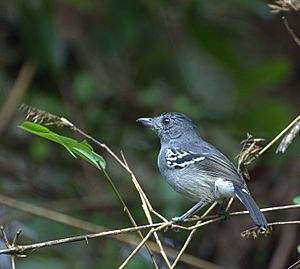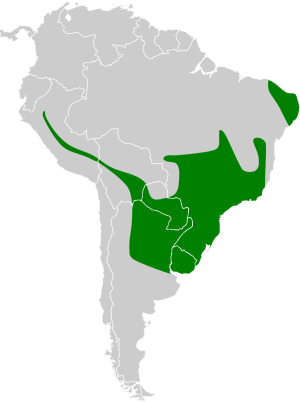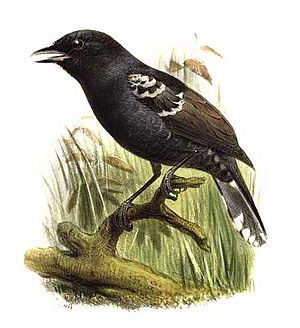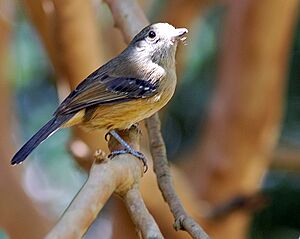Variable antshrike facts for kids
Quick facts for kids Variable antshrike |
|
|---|---|
 |
|
| male Thamnophilus c. caerulescens from São Paulo, Brazil | |
| Conservation status | |
| Scientific classification | |
| Genus: |
Thamnophilus
|
| Species: |
caerulescens
|
 |
|
| Synonyms | |
|
|
The variable antshrike (Thamnophilus caerulescens) is a type of bird found in South America. It belongs to the family Thamnophilidae. This bird is special because its plumage (its feathers) can look very different from one bird to another. That's why it's called "variable"!
Contents
About the Variable Antshrike
The variable antshrike was first described by a French bird expert, Louis Jean Pierre Vieillot, in 1816. He gave it its scientific name, Thamnophilus caerulescens.
Because this bird looks so different and its calls can vary, scientists have wondered if it's actually more than one species. Studies have looked at its DNA and calls. These studies suggest that most of the differences are just variations within the same species. This means birds from different areas can still breed together. However, some groups in north-eastern Brazil are quite unique. Scientists are still studying them to see if they might be a separate species.
What Does It Look Like?
The variable antshrike is a sturdy bird, about 14 to 16 centimeters (5.5 to 6.3 inches) long.
Male Birds
Male antshrikes have black wings with grey edges on their flight feathers. They also have white bars on their wings. These bars can sometimes look like spots. Their tail is black with white tips.
In many parts of its home, the male's chest and head are grey. Its back is grey, sometimes with a lot of black. It has a hidden white patch between its shoulders. The top of its head (crown) is black.
The color of its belly and the feathers under its tail can change a lot. They can be white, grey, or even a deep cinnamon color. One type of male from the Andes mountains in Peru is almost completely black. Another type from Bolivia is also dark but has white stripes on its belly.
Female Birds
Female antshrikes are just as varied as the males. Their wings are usually brownish-black with reddish-brown edges. They have white or light brown wing-bars that often look spotty. However, in north-eastern Brazil, these wing-bars are very small or even missing.
Their tails are similar to the males' but often more brownish. Their underparts are a rich orange-cinnamon color. In some birds, this color goes up to their chest. In others, the chest is pale brown or grey. Their back is brown, and their head is grey or light brown. Most females have a brown crown, but some in central Brazil and the Andes have a black crown.
Both male and female antshrikes have grey legs. They have a short, thick bill that is grey underneath and blackish on top.
Where Do They Live?
The variable antshrike lives in many places across eastern and southern Brazil. It also has separate groups in Ceará, Pernambuco, and Alagoas. From southern Brazil, it spreads into Uruguay, Paraguay, northern Argentina, and Bolivia. It also lives along the eastern side of the Andes mountains in Peru.
These birds can be found in many different types of places with trees. This includes the edges of wet forests and dry woodlands. In many areas, they live in lowlands. But in north-eastern Brazil, they prefer foothills. In the Andes, they live in high mountain areas, sometimes as high as 2,600 to 3,000 meters (8,500 to 9,800 feet).
Life and Habits
The variable antshrike acts like other antshrikes of its kind. You usually find them alone or in pairs. They stay low to the ground, often in thick bushes. This can make them hard to spot!
They mostly eat insects and other small creatures like spiders. They have also been seen eating seeds and fruits. When they are looking for food, they often bob their tail and flick their wings.
Reproduction
These birds breed at certain times of the year, but the exact timing depends on where they live. They build a nest that looks like a woven cup, usually placed low in a bush or tree. Both the male and female take turns sitting on the 2 or 3 eggs.
In southeastern Brazil, breeding starts in October and lasts until January. If a nest fails, perhaps because of a predator, the pair can quickly build a new one. They can even have more than one successful nest in a single season. Scientists have also found that having plenty of food helps them lay more eggs.
Status
The variable antshrike is a common bird. Because of this, organizations like BirdLife International and IUCN say it is of "least concern". This means it is not currently at risk of disappearing.
However, one specific group of these birds, called cearensis, lives in north-eastern Brazil. This area has lost a lot of its natural habitat. So, the future of this particular group might be a bit worrying.
See also
 In Spanish: Batará variable para niños
In Spanish: Batará variable para niños




